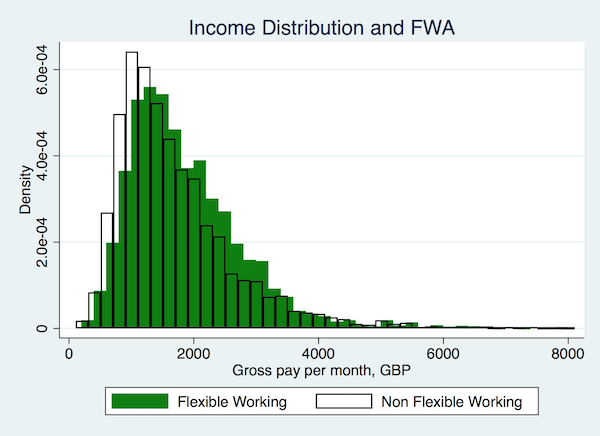
Editor’s note: This post is part of a series showcasing BSE master projects. The project is a required component of all Master’s programs at the Barcelona School of Economics.
Abstract
Our paper examines the wages and career prospects of employees in flexible work arrangements (FWAs). Using the British Household Panel Survey, we analyse the effect of being in a FWA on hourly wages and the likelihood of promotion. We use the occupational share of employees in FWAs before and after the introduction of “Right to Request” (R2R) legislation as an instrument to control for sample selection. Applying our instrument in pooled OLS and linear regression models, we find that flexible workers, particularly women, may receive higher wages than their non-flexible counterparts. This supports theoretical arguments that FWAs could increase labour productivity.
Conclusions
Our findings imply that there may be no penalty associated with workers adopting flexible working practices. Our instrumental variables wage model implies there could in fact be a reverse effect: coefficients changed from negative. In particular, the effect of FWAs was significant and large for women, leading to an approximately 9 percent increase in their wages. Those in FWAs have higher wages than those in conventional working arrangements, controlling for variables such as occupational choice, hours worked, and personal circumstances (including number of children and educational background). Similarly, we cannot reject the hypothesis that FWA has no impact on career progression, when modelling promotions as a 10 percent pay rise versus the previous year.

We do find some evidence that working flexibly decreases the difference in wage outcomes between men and women. The approximately 9 percent increase in wages associated with our FWA variable in our women-only specification compares to a 5 percent increase in our men-only specification. We cannot reject the hypothesis that FWAs have no effect on men’s wages. We find evidence women in FWAs are paid significantly more than their non-flexible counterparts.
This begs the question: why do those in FWAs appear to achieve better labour market outcomes than those not in FWAs? This appears to contradict some findings of economic theory on compensating wage differentials and the effects of similar working arrangements, such as part-time work. Further, the fact that our wage findings were highly significant for women (and not for men) appears to go against the gendered difference in how men and women use flexible working; men are more likely to use FWAs to improve their career outcomes, whilst women use FWAs to accommodate care needs.
First, we could have captured a range of productivity benefits that often come alongside flexible working practices. The increase in schedule control may improve worker satisfaction and hence productivity in itself, but is also often associated with better workplace practices such as improved management (Bloom et al, 2010). The increase in flexible working seen across many sectors (such as services) following the R2R reforms may have disproportionately benefited them ahead of other, less “flexible” sectors. The UK, with more than two-thirds of its labour force in the service sector, may have seen a productivity rise associated with more employees having greater scheduling control. Increases in productivity may then have been passed on to flexible-working employees in the form of pay rises above the mean.
Second, our model may neglect important social trends. The R2R legislation may have accompanied shifting attitudes towards flexible working, which spurred an increase in the compensation afforded to flexible workers. Future research examining historical trends in the remuneration of employees in FWAs could provide more detail on this.
Connect with the authors
About the BSE Master’s Program in Economics of Public Policy
